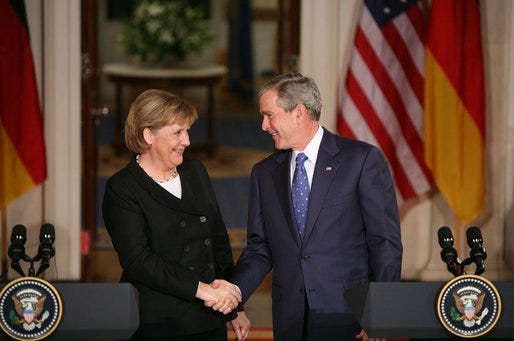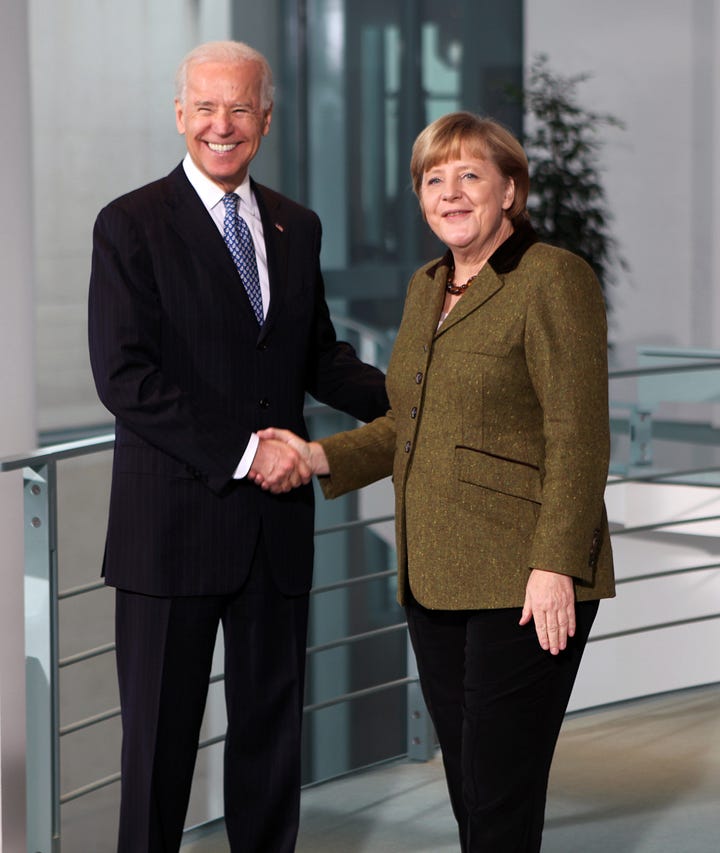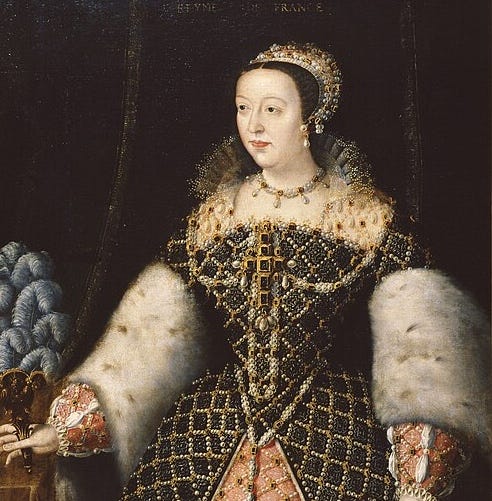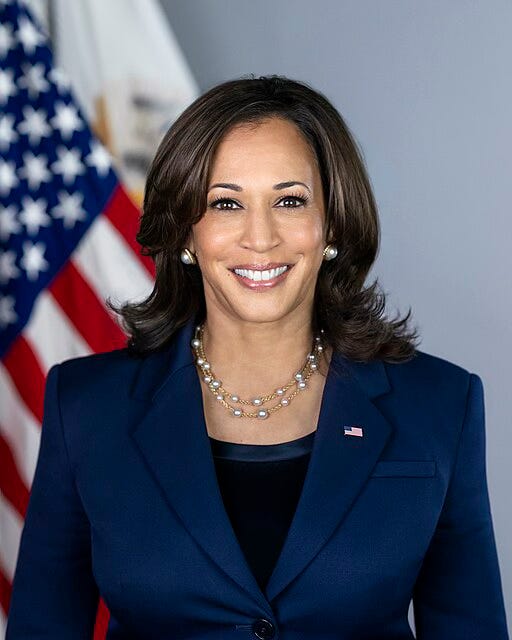But really, what will she wear?1
A recent article by Vanessa Friedman in the New York Times asked the question that we knew would eventually come up: what does the future female president of the United States wear to look “presidential”? Friedman argues that Harris is already performing presidency. She is walking the walk, waving the wave, doing everything possible to electrify the electorate. Except, perhaps, wearing electrifying clothes.
And that’s on purpose.
Pantsuits. A nondescript necklace. Silk shell tops. We all know how charged the question of what to wear is for any professional woman, let alone a woman in a leadership role. How will people read her? How will they judge her? Will she be relatable? What about (oh no!) the dreaded question of authenticity?2 What color communicates power but also approachability - if approachability is in fact what a female president wants to communicate? Should she wear red? Pink? A more masculine blue or black? So many choices, so many opportunities to get it right - or wrong.
Since becoming the presumptive, and now official, Democratic nominee, Harris seems to have taken a page from another female leader whose sartorial choices undoubtedly contributed to her success - at least they didn’t get in her way.
When Angela Merkel of Germany became chancellor in 2005, she began to work with a Hamburg-based designer named Bettina Schoenbach. “Style is an expression of personal choices made many time over,” Schoenbach has said, and Merkel’s style involved outfits that would take the fashion question off the table. Over and over again, Merkel aimed for neutrality: the blazer, the wide-legged trouser, the black flat, the Longchamp bag (practical, tasteful, European, and not too expensive).




Soon, Merkel’s style became almost a trademark. Simple, classic, a woman’s version of a man’s suit - her ensembles were no-nonsense and unobjectionable. They also weren’t overtly political, except perhaps to endorse a certain German (and pro-woman) pride: by 2015, Bettina Schoenbach was designing Merkel’s outfits almost exclusively.
The style worked for the German Merkel. Will it work for the American Harris? So far, so good, it seems. Harris’s suits are communicating that, with about 90 days until the election, she isn’t faffing around in her closet - no, she means business. Hurray!
But any woman as savvy as Merkel or Harris knows that there is no look that is entirely failsafe for a female leader. People will criticize Harris’s clothes if they want to, because they can. It’s not necessarily that clothing creates the controversy. Rather, if there is already controversy, clothing provides the opening for criticism.
This is true as much for male presidents as for female ones. Remember when Barack Obama decided to forego the tie? To some, this move made him seem modern, unfettered by tradition, cool — others saw this as wildly disrespectful of the office. And remember when Obama decided to drop the flag pin? Republicans pounced: unpatriotic, un-American, and (to the birthers, especially) foreign.
It gets all the more complicated for women. As Friedman pointed out in the NYTimes, when it comes to the White House, fashion has always been the province of the First Lady. How much journalistic ink has been spilled trying to read the layers of meaning behind the sartorial choices of Michelle Obama or Melania Trump? Those choices carry real significance, and we should pay attention to them.
But this intense media focus has also trained us to see White House fashion as specifically gendered, to see high fashion and individuality in politics as female, as opposed to the ubiquitous (male) blue suit, the uniformity of it altered only by the addition or absence of a necktie. It has also trained us to see that kind of fashion as secondary, something to associate with the wives of the presidents, the supporters and helpers — but not really with the presidents themselves. Last, but hardly least, the endless unpacking of the wives’ outfits has also become a form of ancillary entertainment. Is it fun? Yes. Is this unpacking essential to solve economic, political, and environmental crises? Not really.
The traditional syllogism goes something like this: Unique fashion choices = female. Female in White House = First Lady. First Lady = warm and approachable, the champion of specific social causes, and the president’s strongest supporter. The First Lady does her important public service job — but it is understood that she does it in part so that the President can do his even more important job.3
But once there is a woman in the Presidency? That syllogism comes undone. For Ms. Harris to wear any outfit other than a suit that reads “just-like-a-man, but with a feminine cut” risks bringing the world of fashion — with all its attendant meanings of “secondary” and “entertaining,” or worse, “frivolous” — to the presidency itself.
So, the pantsuit it is - by far the safest choice. Still, there may be other, subtle ways for Harris to make presidential fashion her own.
Kamala Harris’s predicament is hardly new. The sixteenth century is known as the age of queens in Europe because so many women found themselves on the throne or in visible positions behind the throne. But since there were few precedents for female rule, these women had to rewrite the rules of governing. They also had to figure out what to wear.
And they didn’t always make the right choices.
When Mary I ascended the throne and became the first crowned queen of England, she was anxious to justify her rule, to draw a clear connection between herself and her father, King Henry VIII, and to emphasize her authority. She and her councilors were more interested in framing her as a “female king.” That is because the idea of a “king” was associated with notions of power and divine virtue, whereas “queen” was a title that usually meant “wife.”
The Catholic Mary loved clothes, and she made a point of dressing opulently, if only to provoke memories of the heady days of the reign of Henry VIII, a strong king. But as her popularity began to plummet in an increasingly Protestant England, Mary’s clothes became a weakness. Once seen as elegant, now their opulence seemed garish and gawdy.
Enter Mary’s half-sister and political rival, the Protestant Elizabeth Tudor. As Mary’s power in England waned, Elizabeth took to wearing simple, understated clothes. An Italian ambassador noted that Elizabeth’s simple outfits let her humility, self-confidence, and natural leadership abilities shine through; Queen Mary, on the other hand, seemed to be trying too hard.
Elizabeth Tudor, modest? Not exactly. In the last years of her sister’s reign, Elizabeth’s seemingly humble dresses were in fact a form of political resistance — even aggression.4
Perhaps the greatest master of clothing as a symbol of power was the sixteenth-century French Queen Mother, Catherine de’ Medici. What Catherine fundamentally understood is that power is intrinsically gendered. Knowing that being a woman was her weakness, she found a way to make her gender and her gendered clothing work for her instead of against her.
Catherine is still remembered as the queen who always wore black. She didn’t start that way; until she was about forty, she wore colorful clothes. But when her husband, King Henry II of France, was killed, Catherine began to wear black exclusively. This was an unusual choice. In France, white was the color normally worn by queens in mourning. But Catherine, born in Florence, decided to follow Italian traditions. She would wear black for the rest of her life.


Within a few years, this symbol of her grief would come to signify a new form of power. When Catherine’s ten-year old son ascended the throne, the widowed Catherine took up the reigns of power as regent, which in France was almost unprecedented. Now, her black clothing began to reveal its political capital. What was once the sign of her mourning became something more: her black robes signified seriousness and dedication. Here was the faithful widow dedicated to preserving the memory of her husband. Here was the tireless mother, putting aside the frivolity of a queen’s clothes to devote herself entirely to France and to the well-being of her son, the new king.
Catherine’s black dresses channeled a powerful idea: that a woman could make a a stable, reliable, and nurturing ruler, because she was a mother. Instead of hiding her femaleness, Catherine leaned into it and embraced it, making it the source of her authority.
Her black outfits also became predictable. She wore them almost without fail in public. Like Angela Merkel hundreds of years later, Catherine realized that if you relentlessly wear the same thing, eventually people will just stop talking about it. This wasn’t about a lack of imagination; it was about control.
Catherine didn’t hesitate to add a touch of whimsical elegance to her black gowns: a flash of white here, a fur collar there, a lace-edged veil. If people wanted to talk about her clothes, let them. She would limit what they could talk about by controlling the details.
In the meantime, Catherine ruled France both officially and unofficially for decades. Foreign monarchs and diplomats addressed themselves to the king, but they often would speak to Catherine at the same time, if not first. And eventually, Catherine’s black outfits became so branded and so identifiable, so instantly visible next to her son the king, that they became synonymous with the very idea of the French crown. Of French power.
Catherine made a dress into both a uniform and a power suit. Rather than go for a female version of male clothing, she made the color of her dress a sign of a distinctly female power. While wearing black, she made people listen to her and obey her, as a queen and as a mother.
And there is no better way to turn a dress into a power suit than by actually doing powerful things while wearing it.
Where does this leave Kamala Harris? Her image is still in the making, but many modern women have employed the same strategies as women from long ago. I can think of at least two powerful women who, like Catherine de’ Medici, controlled the conversation around fashion by channeling our attention toward the smallest details. And those details were decidedly feminine.
Madeline Albright tantalized us with her vast collection of brooches, wearing a different one almost every day. We obsessed over their meaning and let her wear whatever else she wanted.
Then there was Justice Ruth Bader Ginsburg. With Justice Sandra Day O’Connor, Bader Ginsburg adopted a lace collar to wear with her black robes. At first, the collar was a necessary addition to Supreme Court robes that had not been designed with women in mind. The men had a shirt collar and a tie; by comparison, the women’s necklines looked bare. Something didn’t look right. As if the robes and the woman who wore them didn’t quite match up.

But the lace collar pulled it all together. .So Bader Ginsburg collected more collars. They became intertwined with her public image. And now, after her death, that feminine collar is still associated with ideals of liberalism and progressiveness — and with difference. It was a tiny flourish that signaled a genius political strategy. A way of challenging the old tropes and masculine imagery of the Supreme Court to create space for the feminine and the new.
Madame Vice President, and future president: make it your own. Do whatever it takes for us to stop talking about your clothes. Wear a pantsuit, the same cut, the same designer, the same color, ad nauseam. Make it predictable. Maybe like Merkel make it relatively boring — so much so that boring becomes a brand synonymous with “wildly effective.” Like Bader Ginsburg, Albright, and Catherine de’ Medici, consider adding a flourish to focus our attention on the small — a collar, a brooch, a handbag, a favorite color — so that you can concentrate on the big.
That little flourish is itself a feminine symbol of power with a long tradition.
No “if she gets elected…” here. Future tense, plain and simple. I am manifesting.
Questioning her authenticity has been a powerful way to attack a woman leader for centuries. Catherine de’ Medici, featured below, was often accused of being inauthentic. For Harris, the authenticity question has centered on race. This time, however, it doesn’t seem to be working.
Let’s not include Melania Trump in this part of the discussion. That Melania was an unconventional First Lady, who spent her time in the White House on her own terms, is something for feminist critics to grapple with. But that is a topic for another essay.
As queen herself, Elizabeth I went back to embracing elaborate gowns. Eventually, she would revel in her role as England’s foremost fashion influencer. English ladies would race to imitate her clothes, hair, and makeup - for Elizabeth, this was evidence of her power.







I love this so much! Never underestimate the power of fashion. How someone dresses communicates as much about them as what they say. And now that we know who the VP choice is, this Minnesotan is excited to see what the rest of the country has to say about Carharrt and Camo. ;)
Wonderful article. I enjoyed reading it so much.